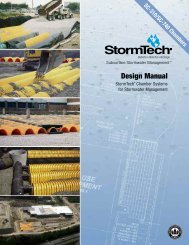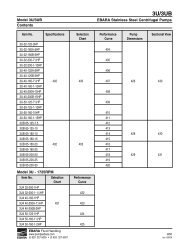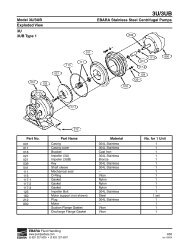Rodney Hunt - International Wastewater Technologies
Rodney Hunt - International Wastewater Technologies
Rodney Hunt - International Wastewater Technologies
You also want an ePaper? Increase the reach of your titles
YUMPU automatically turns print PDFs into web optimized ePapers that Google loves.
2. How does the<br />
cone valve operate?<br />
The Rotovalve cone valve is different from other<br />
through-ported valves (like the ball valve) in its unique<br />
seating/unseating operation.<br />
The plug is raised along the axis of the shaft to<br />
initiate opening of the valve, and lowered to complete<br />
closing of the valve (See Figure 3). This action permits<br />
the plug to rotate freely on journal bearings during the<br />
entire opening/closing sequence which reduces torque<br />
and eliminates seat wear.<br />
STEP 1. The closed position: The Rotovalve seats<br />
drip-tight with the machined Monel faces on both<br />
sides of the plug seating against the machined<br />
Monel surfaces on each side of the body.<br />
STEP 2. Lift actuation: The first movement of the<br />
actuator (manual, electric, or cylinder) moves the<br />
crosshead laterally toward the rotator lever. This<br />
initial lateral movement of the crosshead moves the<br />
lifter lever, which turns the lift nut and raises the plug<br />
away from the body seat. The plug has not turned.<br />
STEP 3. Opening: once the crosshead contacts the<br />
rotator lever, further lateral movement of the<br />
crosshead then turns the plug.<br />
STEP 4. Opening: Close-to-open, and open-to-close<br />
sequence can be adjusted for water hammer control.<br />
The two orifices of the valve (influent and effluent)<br />
drop the unbalanced pressure in two stages,<br />
reducing the potential for cavitation and vibration.<br />
STEP 5. Fully open: once the plug is fully rotated,<br />
continued movement of the crosshead turns the lift<br />
nut, reseating the plug.<br />
Actuator Mechanism Cross Section<br />
Mechanism Housing<br />
Crosshead<br />
Rotator Lever<br />
Lifter Lever<br />
Lifter Link<br />
Roller Guide Rod Figure 2 Figure 3





